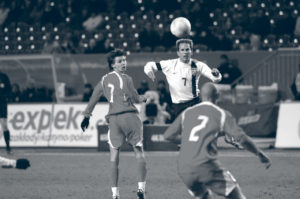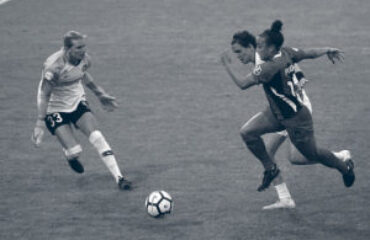Header has long been, and still is, an essential football action. In fact, previous studies with players have been reported to perform on average 2.2–18.5 headers or aerial duels per game and many of the them are decisive for the game outcome. The pattern movement of headers varies depending on variables such as players position, league, teams levels, and header target (e.g., clear, pass). However, headers have been studied from different viewpoints, but none has analyzed the header situations from a descriptive approach during the competition.
“The pattern movement of headers varies depending on variables such as players position, league, teams levels, and header target (e.g., clear, pass)”
Seabra and Dantas (2006) found “Space of Defensive Occupation” to be a reliable indicator for the spatial characterization of team actions. This information would be useful for understanding where, why and how headers are executed in high-performance football.
The available literature on match analysis demonstrated that a deeper analysis of the game situation and techniques used in header situations is still needed. In this sense, the main aims of this study were: (a) to gather detailed information about game situations where headers were performed; (b) to characterize how headers were executed in different game situations.
A sample of 920 headers were randomly collected from the English Premier League 2017–2018 season, using InStat Scout® website platform. Frequency analysis of headers showed that (1) most led to ball losses; (2) almost half was performed during set plays, especially in goal kicks and throw-ins; (3) a substantial amount was executed to prevent spatial progress of opponents when employing direct attacks with long passes.
RESULTS
Analysis of header occurrences according to the game situation:
- Game states of attacking and defensive set plays counted for the majority of headers and, regarding space of occupation, the majority of headers was executed in opponent’s M zone (area between the midfield and the attack sectors).
- Defensive central corridors were locations where headers were mostly executed (26.6%). A considerable number (18.2%) of headers was also executed in P1-P3 zones in the central part of penalty area (Figure 1).
- Goal kicks counted for most of the headers in the game state of set play and no pass was the most common pass type before a header.

Figure 1 (figure 3 in full text). Proportion (%) of headers in different field locations.
Analysis of the header purpose and the way of performing the action:
- Interception was the most used purpose of a header while shots counted for 2.7% of the headers.
- The most commonly used header type in this study was aerial.
- Players moved sideways or backwards majority of the times before a header and, related to jump to a header, 2-feet parallel was used the most.
- Forwards (52%) and central defenders (20%) executed most of the shots, while the most used movement before a shot was >3 steps forward (48%), and the most common jump type 2-feet parallel (48%).
Analysis of association between game situation and the way of performing the header:
- Significant association with a small effect size between the game state and player movement, χ2 (15) = 53.10, p < .001, V = .14.
- There was a significant association with a small effect size between game state and jump type, χ2 (10) = 32.45, p < .001, V = .13.
Analysis of association between header purpose and the way of performing the action:
- Significant association with a small effect size was observed between header purpose and jump type, χ2 (9) = 39.18, p < .001, V = .12.
- Significant association with a large effect size was identified between header purpose and player position, χ2 (12) = 364.99, p < .001, V = .36.
FSI STATEMENTS
- Header actions are variable depending on multiple aspects (e.g., header purpose, presence of opponents, player position). In this sense, jump training should be individualized according to the player requirements in competition.
- Strength and conditioning coach should considers testing jump maneuvers under specific conditions (i.e., movements that mimic situations during the match-play), far from purely vertical movements with multiple restrictions.
- According to the authors, certain positions and areas of the field frequent more header actions. In this line, practitioners should design training programs in order to improve the header performance in isolated conditions.
In the FSI master, the topic is deepened by showing arguments and guidelines for the measurement and training of jump in soccer players.





